Thomas Malory's Le Morte Darthur: Samples from the digitization
35r, line 8 and 45r, line 7
The two scribes of the Winchester Manuscript have been named Scribe A and Scribe B. In these pages, Scribe A, who was the leading figure, started and Scribe B took over the task.
70v
At the end of the 'Tale of King Arthur' (in Vinaver's classification), Malory calls himself a 'knyght presoner':
// And this booke endyth where as sir Launcelot And
Sir Trystrams com to courte. who that woll make
ony more lette hym seke other bookis of kynge Arthure
or of Sir Launcelot or Sir Trystrams ffor this was
drawyn by a knyght presoner Sir Thomas Malleorre
that god sende hym good recouer Amen &c
Explicit
The word 'Explicit' is written in red.
71r
A pen-flourished Lombardic capital letter, H, at the beginning of the Roman War episode. Caxton consciously edited this episode, and so did the Winchester scribe particularly at the beginning.
124r
A marginalium in red, written by Scribe B:
Here sir Bew-
maynes ouercom
Sir persaunte
of Inde
187v, line 6
Offset of letter I, Caxton's type 2: Ink smudges on the pages of the Winchester Manuscript suggest that this manuscript was kept in Caxton's workshop sometime in the years 1480 to 1483, during the time when Caxton was preparing his Le Morte Darthur. Pages fresh from his press were laid on the manuscript and the wet ink accidentally transferred reversed images of Caxton's type faces. This suggests that Caxton used the Winchester Manuscript together with another now lost manuscript.
233v, line 2
A scribal correction in red: the scribe erroneously repeated a phrase, and deleted it with a red line.
357v
The drawing of the cross in the margin and the Incipit in red:
In this scene, two knights, Galahad and Melyas de Lyle, who are in the quest for the Holy Grail, 'com to a crosse whych departed two wayes'. Melyas chooses to take 'the way on the lyffte honde'.
'Now turnyth the the tale vnto Syr Melyas de Lyle'

 [
[ [
[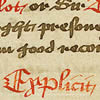 [
[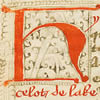 [
[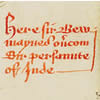 [
[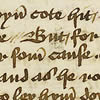 [
[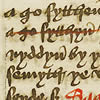 [
[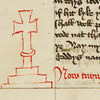 [
[